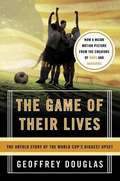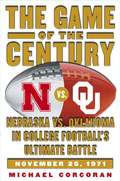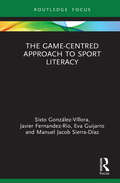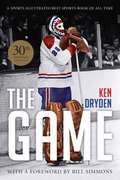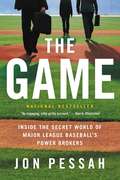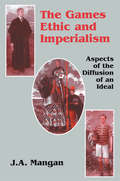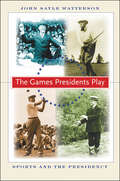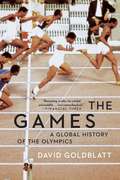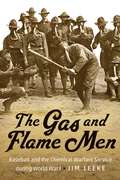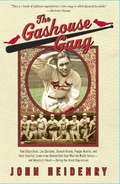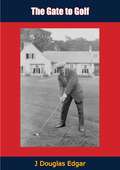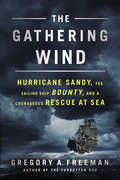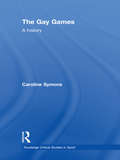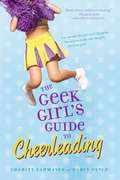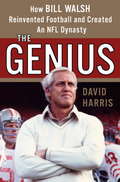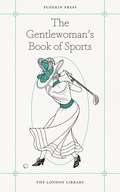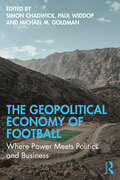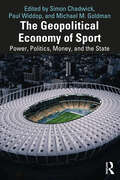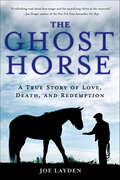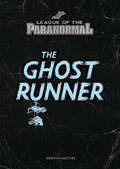- Table View
- List View
The Game of Their Lives: The Untold Story of the World Cup's Biggest Upset
by Geoffrey Douglas<p>In the summer of 1950, a most unlikely group was assembled to represent its country in the first soccer World Cup since World War II. The Americans were outsiders to the sport, the underdogs of the event, a 500-to-1 long shot. But they were also proud and loyal men -- to one another, to their communities, and certainly to their country. Facing almost no time to prepare, opponents with superior training, and skepticism from the rest of the world, this ragtag group of unknowns was inspired to a stunning victory over England and one of the most thrilling upsets in the history of sports. <p>Written by critically acclaimed author Geoffrey Douglas, and now a film directed by David Anspaugh ( Hoosiers ), <i>The Game of Their Lives</i> takes us back to a time before million-dollar contracts and commercial endorsements, and introduces us to the athletes -- the Americans -- who showed the world just how far a long shot could really go.
The Game of the Century: Nebraska vs. Oklahoma in College Football's Ultimate Battle
by Michael CorcoranThe acclaimed author of Duel in the Sun, hailed as "a perfect golf time machine" by USA Today, takes readers into the bleachers and onto the playing field for an inside look at the legendary face-off between the Oklahoma Sooners and the Nebraska Cornhuskers. On Thanksgiving Day 1971, a record fifty-five million homes tuned in to watch two powerhouse college football teams collide. Defending national champion University of Nebraska was squaring off against the country's second-ranked team, the Oklahoma Sooners. The Huskers were riding a twenty-nine-game unbeaten streak; the Sooners had the number one offense in the country. Both teams were loaded with All-Americans and future NFL stars. The legend of the game that became known as the single finest ever played actually began a few years earlier in Texas, when coach Emory Bellard came up with an innovative plan of attack that would level defenses and give coaches sleepless nights for the next twenty years. The Texas wishbone offense became the talk of sporting America, and when Oklahoma coach Chuck Fairbanks adopted it for his team in 1970, the groundwork was laid for the epic confrontation with Nebraska. Combining a meticulously researched history of college football with in-depth interviews, author Michael Corcoran tells it all: the play-by-play strategies and techniques, the personalities of the players and coaches who conceived the plans and executed them, the formations and intricate blocking schemes that spelled victory or defeat. Highlights include: Heisman winner Johnny Rodgers's storied punt return, Rich Glover's incomparable twenty-two tackles, Oklahoma's furious comebacks each time they trailed in the game, and the poignant memories of the game after it was over. Nebraska radio play-by-play man Lyell Bremser echoed the nation when he proclaimed, "I never thought I would live this long to see this kind of a football game." Filled with vivid details and nail-biting suspense, this book takes us behind the scenes and into the rich history of this practically mythical battle. From the roots of both football teams, to the players, coaches, reporters, spectators, and fans, The Game of the Century is a story that will resonate with football fans all across America.
The Game's Not Over: In Defense of Football
by Gregg EasterbrookOn November 17, 1968, the Oakland Raiders staged a last-minute comeback against the New York Jets, scoring two touchdowns in the final minute for a dramatic finale. But there was a problem: no one saw it. NBC, broadcasting the game nationally, cut away with 1:01 remaining and the Jets still leading to air a previously scheduled movie, Heidi. The ensuing public outcry was so significant that the rules for football broadcasting were quickly and forever changed. In this perceptive, finely argued book, Gregg Easterbrook shows that the so-called "Heidi Bowl" was not just an isolated bizarre moment. It was the beginning of the football era in America. The sport boomed alongside television, soon becoming our national campfire--one of the few points of agreement across the political spectrum and a genuine source of community even as religion's influence waned. It is no coincidence, Easterbrook argues, that we now see in football the same issues that we perceive elsewhere in America--including recent problems with bullying, violence against women, racial injustice, and financial skulduggery. These problems are significant, and many have been moved to limit their engagement with the NFL's venal culture--or boycott it entirely. Yet as Easterbrook shows, there's something here worth saving. He expounds on the benefits of football, and throws its many problems into relief, finally arguing that the work of reforming and changing one of our great pastimes is American as the game itself.
The Game-Centred Approach to Sport Literacy (Routledge Focus on Sport Pedagogy)
by Sixto González-Víllora Javier Fernandez-Rio Eva Guijarro Manuel Jacob Sierra-DíazThe Game Centred Approach (GCA) is the ideal framework for coaches and teachers to develop comprehensive tactical or technical lessons for any game, both in physical education and in extracurricular sport contexts. Learning about the pedagogical models included in this approach has never been easier thanks to this short introductory guide. The book helps the reader acquire the skills needed to design effective session plans, regardless of the sport that is being taught or coached. It introduces the core concepts underpinning the GCA model, complemented by practical examples of tasks and strategies for each game category and assessment instrument. This is essential reading for all educators, coaches or sports professionals who wish to improve their teaching or coaching to enhance their students and players’ physical literacy and sport competence. It is also invaluable reading for any student or researcher working in physical education, sport coaching or sport pedagogy.
The Game: 30th Anniversary Edition
by Ken DrydenWidely acknowledged as the best hockey book ever written and lauded by Sports Illustrated as one of the Top 10 Sports Books of All Time, The Game is a reflective and thought-provoking look at a life in hockey. Ken Dryden, the former Montreal Canadiens goalie and former president of the Toronto Maple Leafs, captures the essence of the sport and what it means to all hockey fans. He gives us vivid and affectionate portraits of the characters—Guy Lafleur, Larry Robinson, Guy Lapointe, Serge Savard and coach Scotty Bowman among them—who made the Canadiens of the 1970s one of the greatest hockey teams in history. But beyond that, Dryden reflects on life on the road, in the spotlight and on the ice, offering up a rare inside look at the game of hockey and an incredible personal memoir.This commemorative edition marks the thirtieth anniversary of The Game’s original publication. It includes a new foreword by Bill Simmons, new photography and a new chapter, “The Game Goes On.” Take a journey to the heart and soul of the game with this timeless hockey classic.
The Game: Harvard, Yale, and America in 1968
by George Howe ColtFrom the author of the bestselling National Book Award finalist The Big House comes a story in the tradition of The Boys in the Boat about an unforgettable group of young athletes who battled in the legendary Harvard-Yale football game of 1968 amidst the sweeping currents of one of the most transformative years in American history.On November 23, 1968, near the end of a turbulent and memorable year, there was a football game that would also prove turbulent and memorable: the season-ending clash between Harvard and Yale. Both teams entered undefeated and, technically at least, came out undefeated. The final score was 29-29. To some of the players on the field, it was a triumph; to others a tragedy. And to many, the reasons had as much to do with one side’s miraculous comeback in the game’s final 42 seconds as it did with the months that preceded it, months that witnessed the assassinations of Martin Luther King and Robert F. Kennedy, police brutality at the Democratic National Convention, inner-city riots, campus takeovers, and, looming over everything, the war in Vietnam. George Howe Colt’s The Game is the story of that iconic American year, as seen through the young men who lived it and were changed by it. One player had recently returned from eight months under fire in Vietnam. Two were members of the radical antiwar group SDS. There was an all-American football hero whose nickname was “God.” There was one NFL prospect who quit to devote his time to black altruism, another who went on to be Pro-Bowler Calvin Hill. There was a postal clerk’s son who worried about fitting in with the preppies, and a wealthy WASP eager to prove he could handle the blue-collar kids’ hits. There was a guard named Tommy Lee Jones, and fullback who dated a young Meryl Streep. They came from every class and background, but played side by side and together forged a moment of startling grace in the midst of the storm. Vivid, lively, and constantly surprising, this magnificent and intimate work of history is the story of ordinary people in an extraordinary time, and of a country facing issues that we continue to wrestle with to this day.
The Game: Inside the Secret World of Major League Baseball's Power Brokers
by Jon PessahThe incredible inside story of power, money, and baseball's last twenty years <P><P>In the fall of 1992, America's National Pastime is in crisis and already on the path to the unthinkable: cancelling a World Series for the first time in history. The owners are at war with each other, their decades-long battle with the players has turned America against both sides, and the players' growing addiction to steroids will threaten the game's very foundation. <P><P>It is a tipping point for baseball, a crucial moment in the game's history that catalyzes a struggle for power by three strong-willed men: Commissioner Bud Selig, Yankees owner George Steinbrenner, and union leader Don Fehr. <P><P>It's their uneasy alliance at the end of decades of struggle that pulls the game back from the brink and turns it into a money-making powerhouse that enriches them all. This is the real story of baseball, played out against a tableau of stunning athletic feats, high-stakes public battles, and backroom political deals--with a supporting cast that includes Barry Bonds and Mark McGwire, Joe Torre and Derek Jeter, George Bush and George Mitchell, and many more. <P><P>Drawing from hundreds of extensive, exclusive interviews throughout baseball, The Game is a stunning achievement: a rigorously reported book and the must-read, fly-on-the-wall, definitive account of how an enormous struggle for power turns disaster into baseball's Golden Age.
The Games Ethic and Imperialism: Aspects of the Diffusion of an Ideal (Sport in the Global Society)
by J.A. ManganThis is more than a description of the imperial spread of public school games: it considers hegemony and patronage, ideals and idealism, educational values and aspirations, cultural assimilation and adaptation and the dissemination of the moralistic ideology of athleticism.
The Games Presidents Play: Sports and the Presidency
by John Sayle WattersonThe Games Presidents Play provides a new way to view the American presidency. Looking at the athletic strengths, feats, and shortcomings of our presidents, John Sayle Watterson explores not only their health, physical attributes, personalities, and sports IQs, but also the increasing trend of Americans in the past century to equate sporting achievements with courage, manliness, and political competence.The author of College Football begins with George Washington, whose athleticism contributed to his success on the battlefield and may well have contributed to the birth of the republic. He moves seamlessly into the nineteenth century when, for presidents like Jackson, Lincoln, and Cleveland, frontier sports were part of their formative years. With the twentieth-century presidents—most notably the hyperactive and headline-grabbing Theodore Roosevelt—Watterson shows how the growth of mass media and the improved means of transportation transformed presidential sports into both a form of recreation and a means of establishing a positive self-image.Modern presidents have used sports with varying degrees of success. Herbert Hoover fled Washington on weekends to the trout pools of Camp Rapidan in the Blue Ridge to escape relentless pressures and public criticism during the Great Depression. Franklin Roosevelt demonstrated remarkable physical endurance in his campaign to restore his ravaged body from polio. An obsessive love affair with golf became an issue for Dwight Eisenhower in his campaign for reelection in 1956. Richard Nixon, a former third-string college football lineman, placed calls to Coach George Allen of the Washington Redskins, once suggesting a trick play in a big game.From the opening pitch of the baseball season to presenting awards to Olympic champions, our sports culture asks the president to play an increasingly active role. Sports, Watterson argues, open a window into the presidency, shedding new light on presidential behavior and offering new perspectives on the office and the sporting men—and women—who have and will occupy it.
The Games Presidents Play: Sports and the Presidency
by John Sayle WattersonThis look at the connections between sportsmanship and statesmanship “introduces an intriguing way of evaluating presidential fitness for office” (Richmond Times-Dispatch).Whether throwing out the first pitch of the baseball season, fishing for trout, or cheating at golf, American presidents through history have had connections to the world of sports in many ways. This book explores how various commanders-in-chief worked and played—and how their athletic activities reflected their political identities.The author considers George Washington, whose athleticism contributed to his success on the battlefield and perhaps to the birth of the republic. He moves into the nineteenth century, when frontier sports were part of the formative years of Jackson, Lincoln, and Cleveland. With twentieth-century presidents—most notably the hyperactive, headline-grabbing Teddy Roosevelt—he shows how the growth of mass media and transportation transformed presidential sports into both a form of recreation and a means of establishing a positive image. Exploring everything from FDR’s fight to restore his polio-ravaged body to Eisenhower’s obsessive love affair with golf to Nixon’s enthusiasm for football, this book uses sports to open a window onto the presidency and the nation’s culture, as well as the strengths, weaknesses, and personalities of America’s leaders.“Watterson’s history rises above trivia in its attention to the political ramifications of presidents’ sports while also being a consistently entertaining trove of lore and, as the author puts it, ‘just weird stuff,’ such as John Q. Adams granting an interview while skinny-dipping. A wry and perceptive work.” —Booklist “An enjoyable study of politics and culture.” —Publishers Weekly“Will appeal to history buffs and sports fans alike.” —Library Journal
The Games: A Global History of the Olympics
by David GoldblattThe definitive sports and social history of the modern Olympic Games--by one of the most celebrated sportswriters of our time.Renowned sportswriter David Goldblatt has been hailed by the Wall Street Journal for writing "with the expansive eye of a social and cultural critic" In The Games Goldblatt delivers a magisterial history of the biggest sporting event of them all: the Olympics. He tells the epic story of the Games from their reinvention in Athens in 1896 to the present day, chronicling classic moments of sporting achievement from Jesse Owens to Nadia Comăneci, the Miracle on Ice to Usain Bolt. He goes beyond the medal counts to explore how international conflicts have played out at the Olympics, including the role of the Games in Fascist Germany and Italy, the Cold War, and the struggles of the postcolonial world for recognition. He also tells the extraordinary story of how women fought to be included on equal terms, how the Paralympics started in the wake of World War II, and how the Olympics reflect changing attitudes to race and ethnicity.
The Gas and Flame Men: Baseball and the Chemical Warfare Service during World War I
by Jim LeekeWhen the United States officially entered World War I in 1917, it was woefully underprepared for chemical warfare, in which the British, French, and Germans had been engaged since 1915. In response, the U.S. Army created an entirely new branch: the Chemical Warfare Service. The army turned to trained chemists and engineers to lead the charge—and called on an array of others, including baseball players, to fill out the ranks.The Gas and Flame Men is the first full account of Major League ballplayers who served in the Chemical Warfare Service during World War I. Four players, two club executives, and a manager served in the small and hastily formed branch, six of them as gas officers. Remarkably, five of the seven—Christy Mathewson, Branch Rickey, Ty Cobb, George Sisler, and Eppa &“Jeptha&” Rixey—are now enshrined in the National Baseball Hall of Fame at Cooperstown, New York. The son of a sixth Hall of Famer, player and manager Ned Hanlon, was a young officer killed in action in France with the First Gas Regiment. Prominent chemical soldiers also included veteran Major League catcher and future manager George &“Gabby&” Street and Boston Braves president and former Harvard football coach Percy D. Haughton.The Gas and Flame Men explores how these famous baseball men, along with an eclectic mix of polo players, collegiate baseball and football stars, professors, architects, and prominent social figures all came together in the Chemical Warfare Service. Jim Leeke examines their service and its long-term effects on their physical and mental health—and on Major League Baseball and the world of sports. The Gas and Flame Men also addresses historical inaccuracies and misperceptions surrounding Christy Mathewson&’s early death from tuberculosis in 1925, long attributed to wartime gas exposure.
The Gashouse Gang: How Dizzy Dean, Leo Durocher, Branch Rickey, Pepper Martin, and Their Colorful, Come-from-Behind Ball Club Won the World Series-and America’s Heart-During the Great Depression
by John HeidenryWith The Gashouse Gang, John Heidenry delivers the definitive account of one the greatest and most colorful baseball teams of all times, the 1934 St. Louis Cardinals, filled with larger-than-life baseball personalities like Branch Rickey, Leo Durocher, Pepper Martin, Casey Stengel, Satchel Paige, Frankie Frisch, and-especially- the eccentric good ol' boy and great pitcher Dizzy Dean and his brother Paul. The year 1934 marked the lowest point of the Great Depression, when the U. S. went off the gold standard, banks collapsed by the score, and millions of Americans were out of work. Epic baseball feats offered welcome relief from the hardships of daily life. The Gashouse Gang, the brilliant culmination of a dream by its general manager, Branch Rickey, the first to envision a farm system that would acquire and "educate" young players in the art of baseball, was adored by the nation, who saw itself-scruffy, proud, and unbeatable-in the Gang. Based on original research and told in entertaining narrative style, The Gashouse Gang brings a bygone era and a cast full of vivid personalities to life and unearths a treasure trove of baseball lore that will delight any fan of the great American pastime.
The Gate to Golf
by J Douglas EdgarJames Douglas Edgar (1884-1921) was an English professional golfer and golf writer. He won the French Open in 1914. The Gate to Golf was based on his discoveries made in England. Edgar had an ailing hip which he could not turn freely. Through a series of experiments, he found that a restricted hip turn still allowed a repeatable swing with excellent power and control. This book proved to have significant impact on golf instruction, right up to the present time. Illustrated with photos displaying the technique described in the text.—Print ed.
The Gathering Wind
by Gregory A. FreemanFrom the author of The Forgotten 500 comes the heartbreaking, thrilling, and inspirational story of the impact of Superstorm Sandy upon the Bounty and its crew.
The Gay Games: A History (Routledge Critical Studies in Sport)
by Caroline SymonsThe Gay Games is an important piece of new social history, examining one of the largest sporting, cultural and human rights events in the world. Since their inception in 1980, the Gay Games have developed into a multi-million dollar mega-event, engaging people from all continents, while the international Gay Games movement has become one of the largest and most significant international institutions for gay and lesbian people. Drawing on detailed archival research, oral history and participant observation techniques, and informed by critical feminist theory and queer theory, this book offers the first comprehensive history of the Gay Games from 1980 through to the Chicago games of 2006. It explores the significance of the Games in the context of broader currents of gay and lesbian history, and addresses a wide range of key contemporary themes within sports studies, including the cultural politics of sport, the politics of difference and identity, and the rise of sporting mega-events. This book is important reading for any serious student of international sport or gender and sexuality studies.
The Geek Girl's Guide to Cheerleading
by Charity Tahmaseb Darcy VanceWhen Bethany -- self-proclaimed geek girl -- makes the varsity cheerleading squad, she realizes that there's one thing worse than blending in with the lockers: getting noticed. She always felt comfortable as part of the nerd herd, but being a member of the most scrutinized group in her school is weighing her down like a ton of textbooks. Even her Varsity Cheerleading Guide can't answer the really tough questions, like: How do you maintain some semblance of dignity while wearing an insanely short skirt? What do you do when the head cheerleader spills her beer on you at your first in-crowd party? And how do you know if your crush likes you for your mind...or your pom-poms? One thing's for sure: It's going to take more than brains for this girl genius to cheer her way to the top of the pyramid.
The Genius: How Bill Walsh Reinvented Football and Created an NFL Dynasty
by David HarrisThe Genius is the gripping account of Bill Walsh's career and how, through tactical and organizational skill, he transformed the San Francisco Forty Niners from a fallen franchise into a football dynasty. Along with his right-hand man John McVay, Walsh built the foundation for this success by drafting or trading for a durable core of stars, including Joe Montana, Fred Dean, and Hacksaw Reynolds. (Walsh would later restock the team with such players as Jerry Rice, Steve Young, and Charles Haley.) The key to Walsh's genius perhaps lay in his keen understanding of his athletes' psyches-- he knew what brought out the best in each of them. With unmatched access to players, fellow coaches, executives, beat reporters, and Walsh himself, David Harris recounts the whole story--including Walsh's pre-Niners odyssey, the demons that pushed him throughout his career, and the scope of his impact on the game beyond the field and locker room. In the end, Harris reveals the brilliant man behind the coaching legend.
The Genius: How Bill Walsh Reinvented Football and Created an NFL Dynasty
by David HarrisThe Genius is the gripping and definitive account of Bill Walsh's career and how he built a football dynasty from the rubble of a fallen franchise. David Harris gives a stellar account of the silver-haired sophisticate from humble working-class roots who was hired as head coach and general manager of the San Francisco Forty Niners in January 1979 and became the architect of what is arguably the greatest ten-year run in NFL history. With unmatched access to players, fellow coaches, executives, the reporters who covered the Niners' heyday, and Walsh himself, Harris recounts how Walsh, through tactical and organizational genius, created a football juggernaut. There were also the demons that pushed and haunted Walsh throughout his career: his clash with his former mentor, Paul Brown, who denied Walsh his first pro head-coaching job with the Cincinnati Bengals; Walsh's struggle with self-doubt and criticism; the toll his single-minded devotion to football exacted on his family; and his complex relationship with the Forty Niners' owner, Edward DeBartolo, Jr.Walsh's pre-Niners coaching odyssey was arduous-a longtime assistant coach, he developed his legendary and now-standard pass-oriented West Coast offense during stops at all levels of the game. Despite never having run a team's draft before, Walsh, along with his right-hand man John McVay, quickly built the foundation for a dynasty by drafting or trading for a durable core of stars, including Joe Montana, Fred Dean, Hacksaw Reynolds, Dwight Clark, and Ronnie Lott. (Walsh would later restock the team with such players as Jerry Rice, Steve Young, and Charles Haley.) The key to Walsh's genius perhaps lay in his keen understanding of his athletes' psyches-he knew what brought out the best in each of them. But the scope of Walsh's impact on the game extended well beyond the field and locker room. The Forty Niners' life-skills counseling program, which Walsh spearheaded with the sports sociologist and activist Dr. Harry Edwards, and the internship program Walsh devised to bring minority coaches into the game have since been adopted by the NFL for all league franchises.In the annals of sport, few individuals have had as great an impact on their game-or on its relevance to life outside the lines-as Bill Walsh. With knowledge, skill, passion, and a critical eye, David Harris reveals the brilliant man behind the coaching legend.The vision Bill Walsh brought to all his pioneering efforts was a function of his perception of himself as someone who was far more than a football coach. He cherished his standing and participation in the larger world outside the NFL and nurtured them at every opportunity."Knowing Bill Walsh was kind of like the blind man describing an elephant," one of the sportswriters who covered him observed. "We all knew just one little piece of him. But he had all these other areas we knew nothing about. He dealt with lots of people outside of football, outside of our scope entirely. He was able to deal with politicians, people who were intellects in other areas. They were impressed by him."-from The GeniusFrom the Hardcover edition.
The Gentlewoman's Book of Sports
by Lady Colin Campbell Lady Greville Lady Milner Miss A.D. Mackenzie Miss C. BowlyIt was not easy to be a sportswoman at the end of the nineteenth century. Pierre de Coubertin, founder of the modern Olympic Games, said in 1896: "No matter how toughened a sportswoman may be, her organism is not cut out to sustain certain shocks." Women competed in the Olympics for the first time in 1900.The "white sailor hats" and the "confu- sion between you, your hat, and the ball" in Lady Greville's book may now seem charmingly old-fashioned--until we remember that in 2015, more than a century later, more than 40% of elite sportswomen in Britain were reported to have suffered sexism. Which suddenly makes the bold gentlewomen of 1892 seem far more pioneering...The books in "Found on the Shelves" have been chosen to give a fascinating insight into the treasures that can be found while browsing in The London Library. Now celebrating its 175th anniversary, with over seventeen miles of shelving and more than a million books, The London Library has become an unrivalled archive of the modes, manners and thoughts of each generation which has helped to form it.From essays on dieting in the 1860s to instructions for gentlewomen on trout-fishing, from advice on the ill health caused by the "modern" craze of bicycling to travelogues from Norway, they are as readable and relevant today as they were more than a century ago - even if contemporary sportswomen no longer have to "thank Providence and one's tailor for one's knickerbockers"!From the Trade Paperback edition.
The Geography of Tourism and Recreation: Environment, Place and Space
by C. Michael Hall Stephen J. PageThis fourth edition of The Geography of Tourism and Recreation provides students with a comprehensive introduction to the interrelationship between tourism, leisure and recreation from geographical and social science perspectives. It still remains the only book to systematically compare and contrast in a spatial context, tourism and recreation in relation to leisure time, offering insight into the demand, supply, planning, destination management and impacts of tourism and recreation.Whilst retaining its accessible style and approach this edition has been significantly updated to reflect recent developments and new concepts from geography which are beginning to permeate the tourism and recreational field. New features include: Content on the most recent developments, climate change, sustainability, mobilities and crisis management in time and space as well as trends such as low cost airlines and the control of land transport by transnational operators in the EU such as Arriva. More attention to management issues such as innovation and the spatial consequences for tourism and leisure development. New case studies and examples to showcase real life issues, from both developed and developing countries, especially the US, China and South Africa. Completely revised and redeveloped to accommodate new, user- friendly features: case studies, insights, summary points and learning objectives. Written by leading academics, this is essential reading for all tourism, geography, leisure and recreation students.
The Geopolitical Economy of Football: Where Power Meets Politics and Business
by Simon Chadwick Paul Widdop Michael M. GoldmanThis book examines the new geopolitical economy of football, exploring the intersection of money, politics, and power in the world’s most popular sport. Against a background of international conflict and the emergence of powerful new state actors in world sport, the book considers how football investments and events have become instruments of soft power and industrial development, and how football plays an increasingly significant role in global politics and international relations. Featuring the work of leading researchers from around the world, and case studies from five continents, the book examines key contemporary issues such as the Gulf States’ interests in European soccer and debates around ‘sportwashing’ and human rights, the global politics of artificial intelligence (AI) in football, and football’s complex relationship with migration and identity in Africa and Latin America. It considers the seismic impact of Russia’s invasion of Ukraine on the geopolitics of football; on the shifting landscape of the governance of football in Europe; the rise of Major League Soccer and the ‘Messi effect’, and how the development of China and India into global economic superpowers is reflected in their vision for their domestic football leagues. The book also considers the importance of Fédération Internationale de Football Association (FIFA) and their commercial partners and stakeholders as geopolitical actors on the world stage.This is a fascinating read for anybody with an interest in sport, political economy, international politics, globalisation, or development.
The Geopolitical Economy of Sport: Power, Politics, Money, and the State
by Simon Chadwick, Paul Widdop, and Michael M. GoldmanThis is the first book to define and explore the geopolitical economy of sport – the intersection of power, politics, money, and state interests that both exploit and shape elite sport around the world. Russia’s invasion of Ukraine, the global response, and the consequent ramifications for sport have put the geopolitical economy of sport front and centre in both public debate and academic thinking. Similarly, the Winter Olympics in Beijing and the FIFA World Cup in Qatar illustrate the political, economic, and geographic imperatives that shape modern sport. This book brings together studies from around the world to describe this new geopolitical economy of sport, from the way in which countries use natural resource revenues, accusations of sport washing, and the deployment of sport for soft power purposes, to the way in which sport has become a focus for industrial development. This book looks at the geopolitical economy of sport across the globe, from the Gulf States’ interests in European soccer to Israel seeking to build a national competitive advantage by positioning itself as a global sports tech start-up hub, and the United States continuing to extend its economic and cultural influence through geopolitical sport activities in Africa, Latin America, and the Indian subcontinent. This book captures a pivotal moment in the history of sport and sport business. This is essential reading for any student, researcher, practitioner, or policymaker with an interest in sport business, the politics of sport, geopolitics, soft power, diplomacy, international relations, or international political economy.
The Ghost Horse: A True Story of Love, Death, and Redemption
by Joe Layden“A rollicking read about how magic and the mystifying thrive at the racetrack” from the New York Times–bestselling author (Joe Drape, author of The Saint Makers).In The Ghost Horse, Joe Layden tells the inspiring true tale of a one-eyed, club-footed thoroughbred racehorse and a journeyman trainer, Tim Snyder, who scraped together every penny he had to purchase the broken and unwanted filly.Snyder helped the horse overcome its deficiencies, eventually naming her in part after his deceased wife, Lisa, the great and only love of his life—a bright and sweet-tempered woman whose gentle demeanor seemed eerily reflected in the horse. The trainer (and now owner) was by nature a crusty and combative sort, the yin to his wife’s yang, a racetrack lifer not easily moved by new-age mysticism or sentiment. And yet in those final days back in 2003, when Lisa Snyder lay in bed, her body ravaged by cancer, she reassured her family with a weak smile. “It’s okay,” she’d say. “I’ll see you again. I’m coming back as a horse.”Tim Snyder did not then believe in reincarnation. But he acknowledged the strangeness of this journey, the series of coincidences that brought them together, and the undeniable similarities between the horse and his late wife. And so did those who knew the couple well, and who could now only marvel at the story of the filly, Lisa’s Booby Trap, and the down-on-his-luck trainer who apparently had been given a new lease on life.The Ghost Horse is a powerful horseracing story of underdogs and second chances.“A heart-warming tale, artfully told.” —William Nack, author of Secretariat
The Ghost Runner (League of the Paranormal)
by Norwyn MacTireThere's more than just team superstition at play here. Ollie's best friend, Nate, has always been one step ahead of him—literally—on their cross country team. At the start of senior year, something seems off with Nate, but it's not until Nate gets hurt, bumping Ollie into the top rank on the team, that Ollie realizes what was wrong. There's a ghost that haunts the lead runner on the team—and now that ghost is coming after Ollie. Will Ollie be able to outrun the Ghost Runner and break the cycle once and for all?
